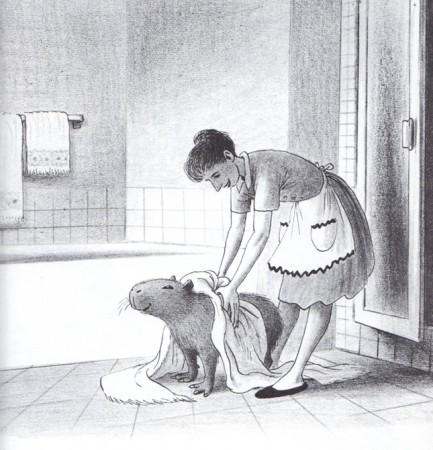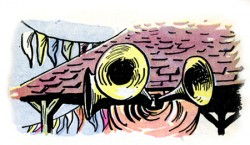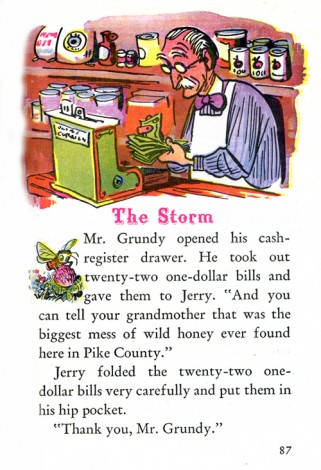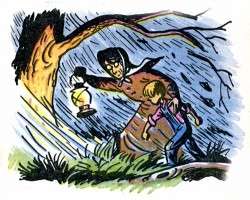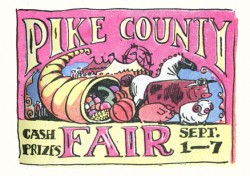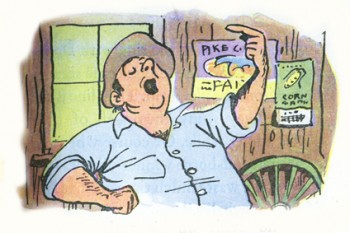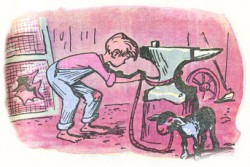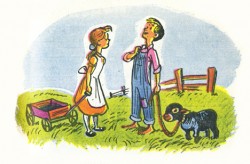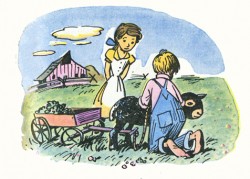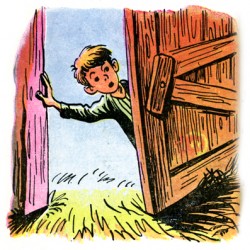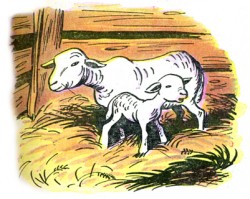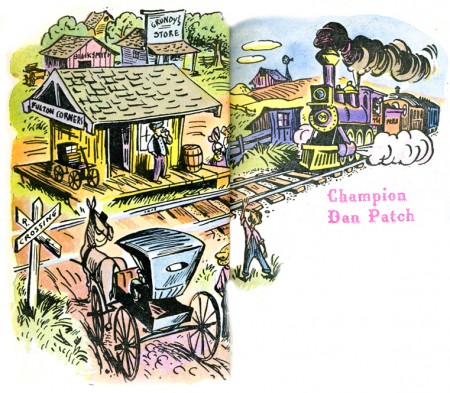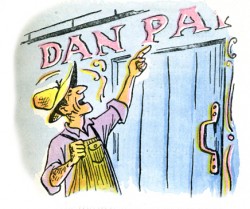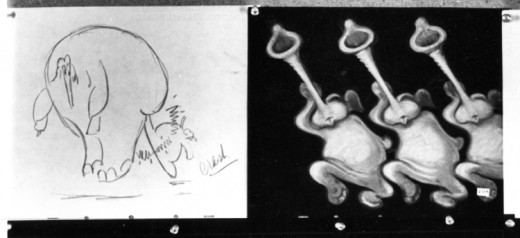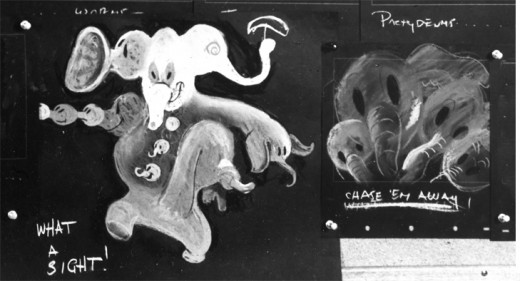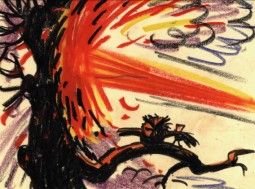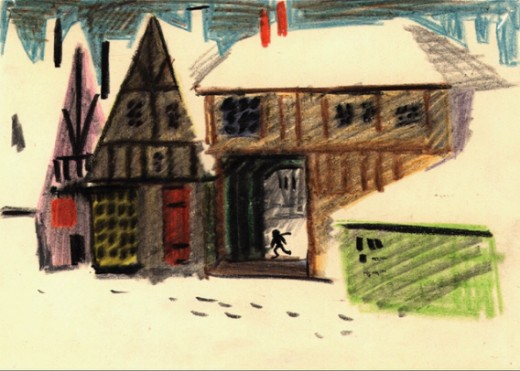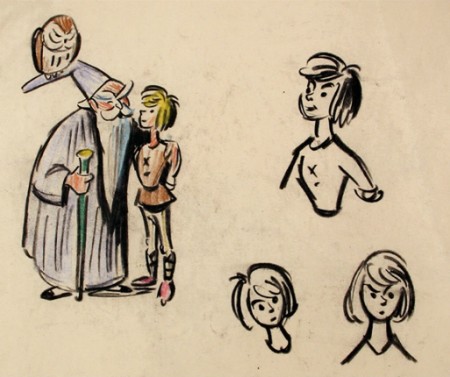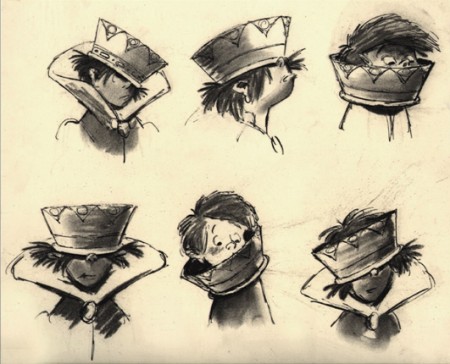Category ArchivePeet
Bill Peckmann &Illustration &Peet 11 Mar 2011 06:51 am
Peet’s Capyboppy – part 2
- Here I continue posting the fine illustrations by Bill Peet for his book, Capyboppy. I’ve chosen not to put Mr. Peet’s writing in the post, feeling it isn’t quite ethical, so have condensed the story so that the illustrations make sense. I would urge you all to buy a copy of this book for the writing alone.
The book’s about 60 pages in length, so it’ll take a couple of more posts to share the artwork. It’s a gem.
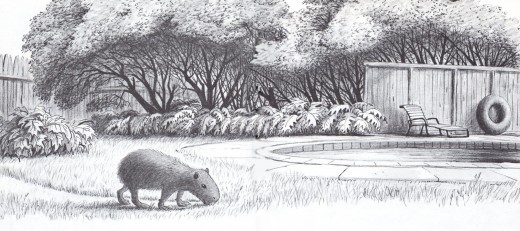
Our new South American visitor couldn’t have been happier in the yard with the swimming pool and the meatly trimmed lawn. At first he enjoyed himself swimming gracefully in the pool, but then it became obvious he needed a playmate.
 22
22
The family worked during the week, but on weekends there were plenty of visitors to keep Capy occupied. He swam when everyone swam and rested when they did, tweeting his tweets as if to join in on the conversation.
 24
24
In the evenings, he joined the family in the family room watching television and sleeping in Margaret’s lap while the cats watched on jealously and miserably. At the end of the evening it was Bill’s job to take Capy out to the garage (kicking and squealing all the way) where he had his bed. He was getting spoiled.
 26
26
His day would begin with a warm shower, after which Margaret dried him with a fluffed towel. After this he ate a nice breakfast of barley and oats.
His favorite food was graham crackers, and some days Margaret would scratch his back with the back-scratcher until every one of his hairs stood on end.
 28
28
There were times we’d leave him in the yard too long until he started Tweeting madly to get us to let him in. One day he came inside the studio while I was drawing and I watched him nose about all the books, magazines and art materials. He ate a grease pencil.
I didn’t mind losing a grease pencil, but he started eyeing some drawings on the wall. I couldn’t lose a month’s work if he ate them, so I pushed him out to the stairwell and rudely shut the door behind him.

I would check on him from time to time to make sure he was safely within the yard. We had a notice on the gate to make sure it was kept closed. But one day, I saw that the gate had been left open and Capy had escaped.
Margaret and I ran out searching for him calling out “Capyboppy! Capyboppy!” No Tweeting response, so we ran to the car to slowly drive about the neighborhood in search of him. Immediately, after we pulled out of the driveway, Margaret shouted, “There he is! There’s Capy!”

Many thanks to Bill Peckmann for scanning and sharing this art with me for the blog.
Animation &Disney &Peet 15 Jun 2010 08:10 am
Bill Peet & Dumbo animation
- There’ve been a lot of comments on my blog about how Bill Peet just about re-animated the bathing scene for Bill Tytla. I thought it worth looking into what I could find in print. To start with anything BUT Peet’s autobiography would be foolish, so let’s see what he wrote about his time on Dumbo within that book.

- The intimidating big business atmosphere of the new building became much less difficult for me when I was assigned to work on Dumbo, the story of the little circus elephant with the enormous floppy ears. Otto Englander, the supervisor of Dumbo, was familiar with my work on Pinocchio and gave me a large part of the story to develop on my own.
The year and a half I spent on Dumbo was a happy time especially since our first son, Bill, was born just the year before I went to work on the picture, and my infant son was a definite influence on the way I drew the baby elephant.

With all my years of sketching and painting the circus I was well prepared for Dumbo, and I contributed so much to the production that Otto allowed me to present my story boards to Walt one day.
In facing Walt for the first time I understood why so many story men became so nervous and shaky they often lost their voices. It was an unnerving experience to concentrate on the boards while Walt leaned forward in his chair as if he were ready to pounce.
Hi fierce scowl was also disconcerting even though it was usually a sign of deep concentration.
I was greatly relieved to make it through the boards without faltering and find Walt relaxed and smiling.
But then Walt was enthusiastic about all my boards on Dumbo, and I thought sure I was established as a full-fledged story man on films to come. No such luck!
Here’s what Peet had to say in an interview done on Hogan’s Alley.
- Bill Peet: Walt got a little stingy with us on Dumbo because they had a showpiece with Bambi. They could play around with little things like the raindrops. Beautiful, but slow and expensive. We weren’t allowed any trimmings. Bambi was a wedding cake. Dumbo was one layer with a little bit of icing. Ours was more successful because it had common appeal, even though the animation was crude in some places. Dumbo didn’t make big money. It had only cost $800,000, so all it had to do to make its cost back was go a little over $1 million. The other features had cost $3 million, plus the cost of the prints, and with no foreign market because of the war.
John Province: Two of the best, Bill Tytla and Fred Moore, worked on Dumbo.
Peet: People were always amazed at Bill Tytla, that he could draw the giant devil for “Night On Bald Mountain,†and the giant in “Brave Little Tailor;†these ponderous, muscled characters, and then do this little elephant. After he got his first scene on Dumbo, he passed me in the hall and said, “Y’know, Bill, I can’t draw these goddamned little elephants. If I send Nick [his assistant] up with the scene, would you see if you could work it out?†Nick brought up this stack of drawings, Bill’s scene where the elephants first appear was just a mess. So I went over every one of them, probably a couple of hundred drawings, every damned frame in the picture, and redrew the whole scene. They shot the pencil test and showed it to Walt. He was ecstatic! Nick came up and told me, “Walt loved that thing, and I want to shake your hand!†Well, Bill never bothered to thank me, Walt either.
Reworking drawings is not animation, and Bill Peet knew that as well. Animation is all in the timing. I also doubt that a sequence that long would have only had “a couple hundred drawings” (even if that isn’t an exaggeration.) I don’t think Peet is giving Tytla his due. Certainly he deserves some attention for pulling the character on model and showing the assistant how to handle it, but there’s a lot more to it.
Mike Barrier, in his inestimably valuable book, Hollywood Cartoons, reports:
- Jackson, who directed all the sequences with significant amounts of animation by Bill Tytla, handed out scenes to Tytla, “but there would be others who would work with him who would do certain scenes…. Quite often Bill would knock out a few poses to get them started and would supervise what they did, very carefully,” to the point that he accompanied those junior animators when Jackson looked at their pencil tests in sweatbox sessions.
 If Tytla had trouble drawing Dumbo, he wouldn’t have had so much authority over the junior animators. I have no doubt Peet got him up and going with the initial scenes, but Tytla is evident in every drawing credited to him in that film. He did that animation.
If Tytla had trouble drawing Dumbo, he wouldn’t have had so much authority over the junior animators. I have no doubt Peet got him up and going with the initial scenes, but Tytla is evident in every drawing credited to him in that film. He did that animation.
Personally, I think this sequence is brilliant enough that both men deserved the credit of genius. It’s one of the high-water marks of animation in its entire history. I also think it’s doubtful that we’ll see its like again.
Books &Disney &Peet 18 Mar 2009 08:06 am
So Dear #5
 - Here’s the conclusion to the Little Golden StoryBook, So Dear To My Heart. The book is an adaptation, of course, of the movie by Helen Palmer with illustrations by Bill Peet.
- Here’s the conclusion to the Little Golden StoryBook, So Dear To My Heart. The book is an adaptation, of course, of the movie by Helen Palmer with illustrations by Bill Peet.
At 128 pages, the book is quite long and chock full of gems by Bill Peet. It’s one of his first publications and shows a lot of the hallmark look he’ll have once he bagan writing and illustrating his own books, although they’re considerably shorter (averaging about 30 pages.) These ink and watercolor illustrations are all spot drawings and fill usually about a third of the page. The colors are limited with an inexpensive printing process used on inexpensive paper. At 5″ x 7″, the book is also a bit smaller than the usual Golden Book.
Here are the last two chapters:

(Click any image to enlarge.)

This drawing, alone, is worth the entire book. It’s beautiful and shows
Peet’s brilliance at capturing characters in a specific moment of time.

Most illustrators would probably have ended the book on this image of
the grand prize winner – such a temptation, the climax of the book.

Peet is character driven and knows that the book is about the boy.
The last image has to be a shot (did I say shot? this isn’t a film. I meant
to say) picture of the real hero of the story . . . the boy.
Books &Disney &Illustration &Peet 11 Mar 2009 08:00 am
So Dear #4
 - This is my fourth installment of Bill Peet‘s illustrations for the Little Golden Book adaptation of the Disney feature film, So Dear To My Heart. The book was written by Helen Palmer and is much longer than other Little Golden Books. It’s novella length and includes many short stories built on the film’s original story.
- This is my fourth installment of Bill Peet‘s illustrations for the Little Golden Book adaptation of the Disney feature film, So Dear To My Heart. The book was written by Helen Palmer and is much longer than other Little Golden Books. It’s novella length and includes many short stories built on the film’s original story.
I believe it’s the first book Bill Peet illustrated, and it led the way to a very successful career after he left Disney’s in the 60s. In his autobiography, Peet doesn’t mention this book. He talks about writing Lambert, the Sheepish Lion as his first potential children’s book. Obviously, he sold that to Disney instead of selling it as a book.
All illustrations are drawn with ink and painted with watercolor. THe printing is done on cheap paper, and the inks have obviously saturated the paper.

(click any image to enlarge.)

There’s something iconic about this image which
strikes a chord with me.
There are two more chapters to go, so one more post. It’s certainly turned into much more work than I’d expected. It should be complete later this week.
Books &Illustration &Peet 06 Mar 2009 09:01 am
So Dear #3
 - Here is the third installment of Bill Peet‘s illustrations for this wonderful Little Golden Book (it’s not so little) adaptation of the Disney feature film, So Dear To My Heart.
- Here is the third installment of Bill Peet‘s illustrations for this wonderful Little Golden Book (it’s not so little) adaptation of the Disney feature film, So Dear To My Heart.
The book, written by Helen Palmer, is quite a bit larger than any other Little Golden Book I’ve seen. It really was a large job for Bill Peet to undertake.
All illustrations are ink with light watercolor. They certainly foreshadow the look of Peet’s children’s books to come some 15 years later.
Looking at the book through the illustrations, alone, one gets the feel of a very innocent, bucolic setting. The problems of the child are front and center, but these aren’t very real problems. This makes for a light series of stories. (To be honest, I haven’t read the text, but there is an overwhelming feeling that comes over you when you spend a bit of time with the images.) The film wasn’t an extraordinary success. I don’t imagine it’d fare better today. In fact, I’d suspect it couldn’t get released by today’s Disney. Maybe if you switched the lamb to a talking chihuahua.

(Click any image to enlarge.)
Thanks to John Canemaker for the loan of the book.
Books &Disney &Illustration &Peet 26 Feb 2009 09:08 am
So Dear #2

- Yesterday, I offered some illustrations by Bill Peet done for a Little Golden Book – excuse me, Golden Story Book.
There are some 126 pages (almost the size of a novel) and an illustration on most of them. These are all spot illustrations done in ink with confident watercolor coloring.
In some odd ways, these illustrations remind me of those for Mike Mulligan and His Steamshovel. Yes, they’re very different – very different. But the feel of them all adds up to something very homespun and similar. Perhaps it’s the coloring process that’s done it, a very washed out look. Despite the fact that these are four color illustrations and those in Mike mulligan are two color.


(Click any image to enlarge.)
More to come next week.
Books &Disney &Illustration &Peet 25 Feb 2009 09:03 am
So Dear To My Heart

- If the Little Golden Books had ever published a novel, this is it. So Dear To My Heart is an encapsulation of the film by Helen Palmer with illustrations by Bill Peet “adapted from the film.”
This collectible item comes from the amazing John Canemaker collection, and I thank him for the loan.
The pictures are mostly small spot illustrations done in ink and watercolor. They’re very simple and give a good indication of Bill Peet’s future books (though he often used pencil for that and allowed the scumbled pencil to add texture.)
Here are the first 20 illustrations (more to come in a future post); there are many. One illustration per page with 125 pages.
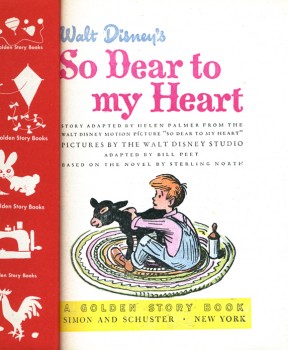
(Click any image to enlarge.)
Disney &Peet &Story & Storyboards 07 Jan 2009 08:51 am
Recap: Tar Baby board – 1
- Back in Oct 2007, I posted Bill Peet‘s excellent storyboard for the Tar Baby sequence from Song of the South.
Given yesterday’s post of color sketches and storyboard drawings from this film, and given that the original posting of these boards was done relatively small, I thought it time to put them up again, but I’ve taken the time to break them down and post them in a slightly larger form, making them a bit more legible.
As with other recent boards loaned me by John Canemaker, I first display them in the original size of the stats as they came to me.
 1
1
(Click to enlarge images so you can read them.)
Here is my breakdown of the boards:
 1a
1a
 42a
42a
I just love the drawings from this section.
There are another two pages of the storyboard
which I’ll break down and post tomorrow.
Animation Artifacts &Disney &Peet &repeated posts &Story & Storyboards 26 Nov 2008 09:35 am
Recap – Pink Elephants
- Recently, I saw a small part of Aladdin on television. A large part of the Genie’s song reminded me of Pink Elephants from Dumbo. I thought then, that I should post anew the models/sketches and drawings from that sequence. It originally was broken in two parts when it saw daylight here in 2007. I’ve combined there into one.
Once again, thanks to John Canemaker, I have several photo images to display. Some frame grabs accompany the piece.

These are rather small images, so by cutting up the large boards and reassembling them I can post them at a higher resolution, making them better seen when clicking each image. It’ll take two days to post them all, so this will be continued later this week.
I’ve interspersed some frame grabs fromt the sequence to give an idea of the coloring.
The following images were in the gallery part of the dvd. These are the color versions of some of the images above.
Animation Artifacts &Disney &Models &Peet &Story & Storyboards 06 Jun 2008 08:25 am
Recap Friday – Wizard’s Duel Storyboard
 – Here is a preliminary storyboard done by Bill Peet of the Wizard’s Duel from Disney’s Sword In The Stone. It’s another gem on loan from John Canemaker, and is a companion to the piece I posted last Friday by Peet. The oddity of this board is that it’s dated April 1949. (The numbers at the bottom of the board clearly read “449.”) I didn’t have any clue that this film was in development that early. The book was published in 1938, so it’s quite feasible.
– Here is a preliminary storyboard done by Bill Peet of the Wizard’s Duel from Disney’s Sword In The Stone. It’s another gem on loan from John Canemaker, and is a companion to the piece I posted last Friday by Peet. The oddity of this board is that it’s dated April 1949. (The numbers at the bottom of the board clearly read “449.”) I didn’t have any clue that this film was in development that early. The book was published in 1938, so it’s quite feasible.
If that date is accurate, it’s amazing how close the characters stay to their final models. This could easily be explained with the heightened us of xerography in animation after 1958. Post 101 Dalmatians, this loose style was easy to translate into animation, and Ken Andersen was easily able to adapt to this style by Bill Peet that all of the animators in the studio loved.
 A
A
Click on any image to enlarge
 B
B
Note in row 2 how the spider turns into the tiger’s face; it’s a graphic turn. This never would have made it to the final in a Disney film, and it didn’t.
 C
C D
D
I love how extra drawings which have been pulled make it to the bottom of the second board.
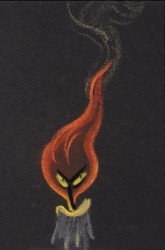 - I always thought Disney’s The Sword In The Stone a somewhat underrated film. The background art is sensational, and several sequences are brilliantly animated.
- I always thought Disney’s The Sword In The Stone a somewhat underrated film. The background art is sensational, and several sequences are brilliantly animated.
Bill Peet‘s adaptation from TH White‘s book, The Once and Future King, loses some of its poetry in the adaptation, but the book’s storyline features a lot of rambling making it hard to construct a screen story. I’ve watched this film quite a few times over the years, and somehow it always gives me a bit of a charge that comes with many of the older classics.
The extras on the dvd seems to consist predominantly of storyboard drawings by Bill Peet. So why not show them off? There’s no continuity to attend to, hence the images are gathered in small clusters. The sequence everyone jumps to analyze and discuss is the Wizard Duel between Merlin and Madame Mim (animated by Milt Kahl.) Consequently, a lot of the drawings on the dvd come from this sequence. I, personally, would have loved seeing some of the squirrel section. I found it quite moving and full of real character stuff. It would be nice to see how Peet developed this.
There’s no hint of a continuity on the dvd, but I’ve heard that the storyboard drawings in the vault are just placed in manilla envelopes with no suggestion of an order. It would make sense that they’ve just plopped these images on the dvd as they have with no order, details or related information.

_______Here’s a creature that never made it to the battle of the wizards.
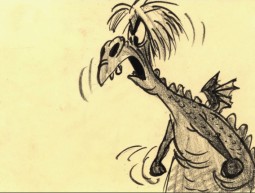 _
_
_________________________(Click any image to enlarge.)
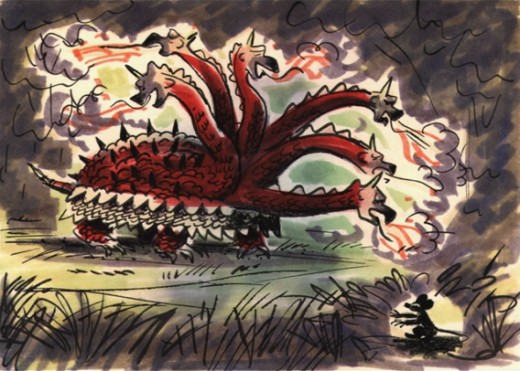
___________Another fantastic creature that didn’t make it into the film.

I’m not sure if this drawing is also from the duel. Or was it another sequence where Wart becomes an animal – cut out of the film?
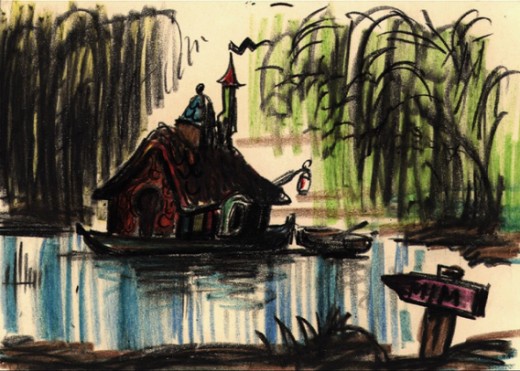
This looks like it may have been planned as a home for Merlin. Did it inspire anything for The Rescuers?
_____
Here are a couple of models Peet obviously did –
_______________________probably more for himself than anything.
______ _
_




